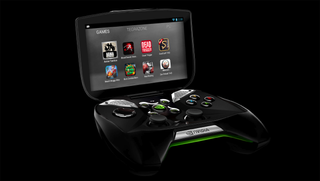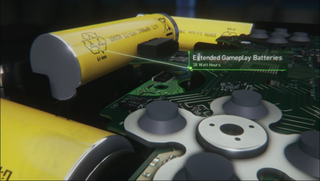Project Shield - Everything we know about Nvidia's game console
Get caught up on Nvidia's thing

Nvidia is making a handheld console
At a pre-CES press conference last night, Nvidia unveiled a portable, Android-powered gaming console currently titled "Project Shield." No, we didn't see it coming either. The system is built into a full-size controller thats a little bit bigger than that of the Xbox 360's, but with a 5-inch 720p touch screen display attached to the top. Its very reminiscent of those old travel monitors for the PlayStation and PlayStation 2, except, you know, its on a controller.
Thats not the best part though; It also allows for streaming of games from a PC through a local network and has support for Steams Big Picture mode. Theres even talk of support for Nvidias future cloud streaming service, Grid. Project Shield is still very new and while we dont know much at this point, this is everything we know about it so far.

It has a 5-inch touch screen w/ 720p display...
Project Shield utilizes a 5-inch 720p multi-touch screen display attached to the back of the controller via a hinge. With a resolution of 1280x720 and 294dpi pixel density, its somewhat comparable to that of the Retina Display that Apple has been putting in its recent products.
The screen contains Direct Touch technology that claims to offer smoother and more accurate touch functionality compared to standard Android devices, which haven't always had the strongest touch support. The screens touch capabilities are made for Android and wont work while in Steam Big Picture Mode, though, but there's a better way to control games than with the touch screen.

...and an Xbox 360-like controller
Claiming "console-grade" controls, Project Shield follows the typical trigger, shoulder, and face button configuration made famous by the Xbox 360, but opts to switch the directional pad and left analog stick to closer resemble that of the PlayStation 3s Dualshock.
In the center of the controller we have a start button, volume control button, a central guide button with the Nvidia logo (that also serves as a power button), and both a back and home button in the typical Android fashion. Theres a bit of ergonomic styling to the controller as well, with recessed areas around the base of the analog sticks.

It's a clamshell design with customizable back plate "shields"
Nvidia is using a clamshell design that folds the screen down on top of the face of the controller for protection, just like the 3DS. This also gives it a sleek enough profile that you can carry it around in your bag without worrying about the analog sticks getting snagged on anything, which was our initial control.
The backplate "shield" also snaps off and allows you to swap in other designs at will. Its more of a cosmetic thing, but its neat to have physical customization possible. No word yet on how much these customizable shields will cost, though.

It's using the new Tegra 4 processor
Originally the star of Nvidias pre-CES press conference, the Tegra 4 was also announced alongside Project Shield touting the title of the worlds fastest mobile processor.
It is nearly ten times faster than anything out there on the market right now, carrying 72 custom Nvidia GeForce CPU cores (six times whats in the Tegra 3), the first quad-core ARM Cortex-A15 CPU, and new tools to extend the battery life of compatible products. This allows for your games to look better on a higher resolution display, and thats all you need to know.

It runs on "pure Android"
We know that Project Shield runs on the latest version of Android, JellyBean, but it requires the use of TegraZone, Nvidias closed-market DRM-enabled game store, as well. This is because games have to be specially optimized to use the controller, so you cant just use it with any game that you find in Google Play.
Dont fret though--there are plenty of games already optimized to work with TegraZone, including Burn Zombie Burn! and Dead Trigger 2, the sequel to the highly successful iOS and Android title. We can only expect that list to grow as more developers join to take advantage of the hardware.

It lets you stream PC games from within the same house...
If you have a gaming PC that meets the minimum specs and houses a GTX 650 or higher, Project Shield will allow for streaming of PC titles over local Wi-Fi (using the built-in 802.11n chipset) to the display and control using the handheld.
This is only further reinforced by support for Steams Big Picture mode, which can be navigated using the controller. This opens the door to automatic support for any title that supports "gamepad support" through Steam, of which there are plenty.

...and maybe further in the future, from the cloud...and maybe even from further away in the future
During the same press conference, Nvidia also showcased their cloud-streaming hardware/software duo, Grid, a computing card which promises to help aid in pushing the processing power of games into the cloud so that spreading our PC games across multiple devices can become a reality.
If widely adopted, this could be integrated with Project Shields streaming ability to allow for portable PC gaming wherever you have a Wi-Fi connection. Nothing of that nature was confirmed at this time though, and it sounds like were still a little ways out from that, but Nvidia definitely hinted at the possibility of playing your PC games on Project Shield from outside Wi-Fi's reach.

It can stream to a TV via HDMI
Using the built-in HDMI port on the top of the controller, Project Shield can stream gameplay from the display to any HDMI display, including 4K resolution TVs, without any latency. This allows for flexibility in content consumption and even the streaming of games, movies, and music to your television.
And yes, you can totally pump out the feed thats being streamed over Wi-Fi from your PC, making it the easiest way to get your Steam content on your TV without the need for another box or long HDMI cable. It also supports a variety of wireless displays, including Miracast, for full wireless video streaming.

It has all the standard ports youve come to expect
Youd be hard-pressed to find an Android-powered device that doesnt have a microSD slot and HDMI out, but Project Shield takes it a bit further by opting for a full HDMI port rather than a mini- or use of a dongle, making it much more simple to grab an HDMI cable and go.
Theres also a micro-USB port on the back, which, so far, we know can be used for charging...and not much else. While the device is open and running stock Android, we arent yet sure of the openness to rooting, for which the port could come in handy.

It has bangin audio
Theres a headphone port on the rear of the device between the triggers, but theres also two built-in speakers on the front of the controller. The sound system has been selectively tuned to offer more oomph in the bass and low-frequency department to make sure that you hear every explosion possible in a way "never before experienced on a portable device".

It can access other Android apps such as Netflix, Hulu Plus, and more
While everything in Google Play might not be compatible with the controller, you can download anything that runs on Android through Google Play by way of the Androids standard touch controls. These allow for video streaming through Netflix, Hulu Plus, and a number of other similar services.
This also means that youll have access to apps like Facebook, Slacker Radio, YouTube, Google Music, Browser, and any of the other apps that call Android home. It isnt clear whether access to the Amazon App Store will be allowed, but we wouldnt hold your breath.

It has a reported 5-10 hour gameplay battery life, 24 hour video
Nvidia is claiming a five-to-ten hour battery life through gameplay (presumably Android gaming, not streaming from the PC, which would be significantly less) and up to 24 hours of video playback. Thats actually above average compared to the other handheld consoles on the market right now, so hooray for that.
This is due in part to the large, built-in rechargeable lithium ion batteries, and the PRISM 2 technology found within the Tegra 4 processor, which is specially designed to save energy in conjunction with the battery-saver core.

The name will probably change
It isnt likely that Project Shield will keep the same name for long, as most early projects dont. The Nintendo Wii was originally the Revolution, and the next Xbox and PlayStation consoles even have codenames, Durango and Orbis, respectively.
Project Shield sounds like more of an internal development title that anything else, but as we start to hear more, you can bet that Nvidia will name it something more marketable and consumer-friendly. We're guessing they're go with something like "Nvideo game console supreme Android master streaming device," or NGCSAMSD for short. Yeah, pretty sure that's it.

It's coming out Q2 2013
We dont have an official price or release date as of yet (gulp), but Nvidia did do us the favor of confirming that Project Shield would be released sometime within the second quarter of 2013. That's actually pretty soon--sooner than we thought, at least.
Q2 spans April 1 to June 30. Thats not too far away from now, and since were rapidly approaching that unknown release date, its safe to say that well be hearing more new details sometime soon.

Next-gen looks interesting
We dont yet know what the next generation of consoles has in store for us, but if the creativity behind Project Shield is any indication, we cant wait to see what Microsoft and Sony have up their sleeves. But for now, were perfectly content playing our full PC games on the couch, even if we do need to use a controller, because lets be real: streaming games over Wi-Fi to a controller with a screen on it? Were already living in the future.
And if you're looking for more alternative consoles, check out 7 reasons Ouya deserves your attention and Xbox 720 rumors.
Gorgeous JRPG homage Clair Obscur sells out its collector's edition months before launch, dev says it didn't think "the demand for our physical editions would be so high"
Turn-based RPG Clair Obscur dev says all-star voice actor lineup includes people like Andy Serkis and Baldur’s Gate 3 alumni by accident: "He was like, 'Isn't that Clive from Final Fantasy?'"
Gorgeous JRPG homage Clair Obscur sells out its collector's edition months before launch, dev says it didn't think "the demand for our physical editions would be so high"
Turn-based RPG Clair Obscur dev says all-star voice actor lineup includes people like Andy Serkis and Baldur’s Gate 3 alumni by accident: "He was like, 'Isn't that Clive from Final Fantasy?'"
Most Popular



